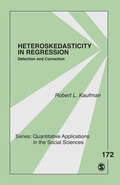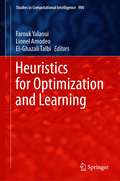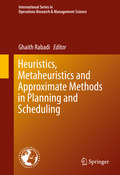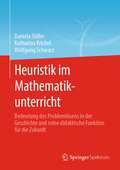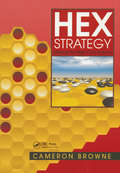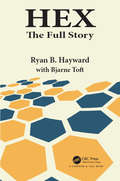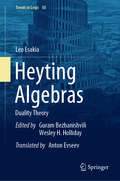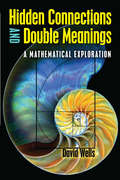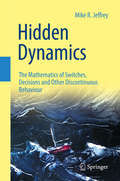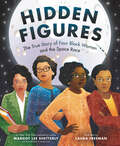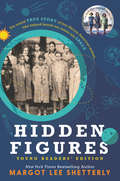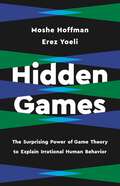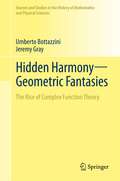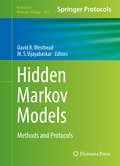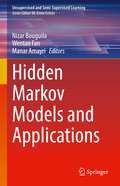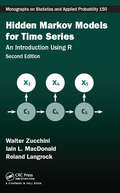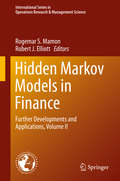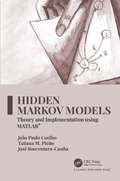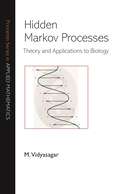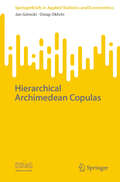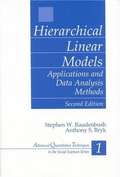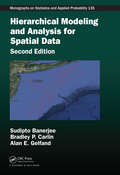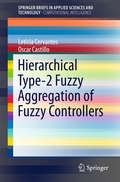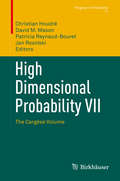- Table View
- List View
Heteroskedasticity in Regression: Detection and Correction
by Robert L. KaufmanHeteroskedasticity in Regression: Detection and Correction, by Robert Kaufman, covers the commonly ignored topic of heteroskedasticity (unequal error variances) in regression analyses and provides a practical guide for how to proceed in terms of testing and correction. Emphasizing how to apply diagnostic tests and corrections for heteroskedasticity in actual data analyses, the monograph offers three approaches for dealing with heteroskedasticity: (1) variance-stabilizing transformations of the dependent variable; (2) calculating robust standard errors, or heteroskedasticity-consistent standard errors; and (3) generalized least squares estimation coefficients and standard errors. The detection and correction of heteroskedasticity is illustrated with three examples that vary in terms of sample size and the types of units analyzed (individuals, households, U.S. states). Intended as a supplementary text for graduate-level courses and a primer for quantitative researchers, the book fills the gap between the limited coverage of heteroskedasticity provided in applied regression textbooks and the more theoretical statistical treatment in advanced econometrics textbooks.
Heuristics for Optimization and Learning (Studies in Computational Intelligence #906)
by Lionel Amodeo Farouk Yalaoui El-Ghazali TalbiThis book is a new contribution aiming to give some last research findings in the field of optimization and computing. This work is in the same field target than our two previous books published: “Recent Developments in Metaheuristics” and “Metaheuristics for Production Systems”, books in Springer Series in Operations Research/Computer Science Interfaces. The challenge with this work is to gather the main contribution in three fields, optimization technique for production decision, general development for optimization and computing method and wider spread applications. The number of researches dealing with decision maker tool and optimization method grows very quickly these last years and in a large number of fields. We may be able to read nice and worthy works from research developed in chemical, mechanical, computing, automotive and many other fields.
Heuristics, Metaheuristics and Approximate Methods in Planning and Scheduling
by Ghaith RabadiThe scope of this book is limited to heuristics, metaheuristics, and approximate methods and algorithms as applied to planning and scheduling problems. While it is not possible to give a comprehensive treatment of this topic in one book, the aim of this work is to provide the reader with a diverse set of planning and scheduling problems and different heuristic approaches to solve them. The problems range from traditional single stage and parallel machine problems to more modern settings such as robotic cells and flexible job shop networks. Furthermore, some chapters deal with deterministic problems while some others treat stochastic versions of the problems. Unlike most of the literature that deals with planning and scheduling problems in the manufacturing and production environments, in this book the environments were extended to nontraditional applications such as spatial scheduling (optimizing space over time), runway scheduling, and surgical scheduling. The solution methods used in the different chapters of the book also spread from well-established heuristics and metaheuristics such as Genetic Algorithms and Ant Colony Optimization to more recent ones such as Meta-RaPS.
Heuristik im Mathematikunterricht: Bedeutung des Problemlösens in der Geschichte und seine didaktische Funktion für die Zukunft
by Wolfgang Schwarz Daniela Stiller Katharina Krichel„Problemlösen durch Mathematik? Mathematik ist doch das Problem …“Dass Mathematik als sinnfällig und nachvollziehbar, als ein praktisches Instrument zur Erreichung der eigenen Ziele erlebt wird, stellt in der Bildungsbiographie eine Ausnahme dar. Tatsächlich ist Mathematik wohl das unbeliebteste und ‚schwierigste‘ Fach in der Schule – und oft kommt vorwurfsvoll die Frage hinzu: Wozu brauche ich das überhaupt?Die Situation ist dabei weder Zufall noch schicksalhaft, sondern Folge einer verfehlten Didaktik. Nur ein Neudenken schulischen Unterrichts und eine gründliche Rückbesinnung auf das, was Mathematik ihrem Wesen und Ursprung nach ist, wird für Lernende wie Unterrichtende den lange schwelenden Konflikt auflösen und endlich Wege für alle in die Welt der Mathematik weisen können. Und dabei kann die Heuristik der Schlüssel sein.
Hex Strategy: Making the Right Connections (AK Peters/CRC Recreational Mathematics Series)
by Cameron BrowneHex Strategy is the first book to offer a comprehensive look at the game of Hex, from its history and mathematical underpinnings to discussions of advanced playing techniques. This is first and foremost a book on strategy aimed at providing sufficient knowledge to play the game at any level desired. Numerous examples illustrate an algorithmic approach to the game. Hex Strategy is a book for board game enthusiasts, recreational mathematicians and programmers, or simply those who enjoy games and puzzles.
Hex: The Full Story (AK Peters/CRC Recreational Mathematics Series)
by Bjarne Toft Ryan B. HaywardHex: The Full Story is for anyone - hobbyist, professional, student, teacher - who enjoys board games, game theory, discrete math, computing, or history. hex was discovered twice, in 1942 by Piet Hein and again in 1949 by John F. nash. How did this happen? Who created the puzzle for Hein's Danish newspaper column? How are Martin Gardner, David Gale, Claude Shannon, and Claude Berge involved? What is the secret to playing Hex well? The answers are inside... Features New documents on Hein's creation of Hex, the complete set of Danish puzzles, and the identity of their composer Chapters on Gale's game Bridg-it, the game Rex, computer Hex, open Hex problems, and more Dozens of new puzzles and solutions Study guide for Hex players Supplemenetary text for a course in game theory, discrete math, computer science, or science history
Heyting Algebras: Duality Theory (Trends in Logic #50)
by Leo EsakiaThis book presents an English translation of a classic Russian text on duality theoryfor Heyting algebras. Written by Georgian mathematician Leo Esakia, the text provedpopular among Russian-speaking logicians. This translation helps make the ideasaccessible to a wider audience and pays tribute to an influential mind in mathematicallogic. The book discusses the theory of Heyting algebras and closure algebras, aswell as the corresponding intuitionistic and modal logics. The author introduces thekey notion of a hybrid that “crossbreeds” topology (Stone spaces) and order (Kripkeframes), resulting in the structures now known as Esakia spaces. The main theoremsinclude a duality between the categories of closure algebras and of hybrids, and a dualitybetween the categories of Heyting algebras and of so-called strict hybrids.Esakia’s book was originally published in 1985. It was the first of a planned two-volume monographon Heyting algebras. But after the collapse of the Soviet Union, the publishing houseclosed and the project died with it. Fortunately, this important work now lives on inthis accessible translation. The Appendix of the book discusses the planned contentsof the lost second volume.
Hidden Connections and Double Meanings: A Mathematical Exploration
by David WellsEverything in mathematics has many meanings — every diagram and every figure, every sum and every equation can be "seen" in different ways, just as every sentence in English or in algebra can be variously read and interpreted. This book explores mathematical topics by pointing out remarkable similarities and taking a fresh look at familiar items. Loaded with thought-provoking facts and surprises, it explores the relationships between mathematics and humor, shows how mathematicians use metaphors to name the nameless and to point to hidden connections, and presents a series of challenging puzzles that offer thought-provoking fun.You don't have to be a mathematician to appreciate this playful approach to numbers, patterns, graphs, and pictures. Author David Wells focuses on insight and imagination rather than technique, emphasizing the mystery, intrigue, and other pleasurable aspects of mathematics. Hints for the captivating problems and puzzles appear at the end of the book, in addition to complete solutions.
Hidden Dynamics: The Mathematics of Switches, Decisions and Other Discontinuous Behaviour
by Mike R. Jeffrey<p>The dream of mathematical modeling is of systems evolving in a continuous, deterministic, predictable way. Unfortunately continuity is lost whenever the `rules of the game' change, whether a change of behavioural regime, or a change of physical properties. From biological mitosis to seizures. From rattling machine parts to earthquakes. From individual decisions to economic crashes. <p>Where discontinuities occur, determinacy is inevitably lost. Typically the physical laws of such change are poorly understood, and too ill-defined for standard mathematics. Discontinuities offer a way to make the bounds of scientific knowledge a part of the model, to analyse a system with detail and rigour, yet still leave room for uncertainty. This is done without recourse to stochastic modeling, instead retaining determinacy as far as possible, and focussing on the geometry of the many outcomes that become possible when it breaks down. <p>In this book the foundations of `piecewise-smooth dynamics' theory are rejuvenated, given new life through the lens of modern nonlinear dynamics and asymptotics. Numerous examples and exercises lead the reader through from basic to advanced analytical methods, particularly new tools for studying stability and bifurcations. The book is aimed at scientists and engineers from any background with a basic grounding in calculus and linear algebra. It seeks to provide an invaluable resource for modeling discontinuous systems, but also to empower the reader to develop their own novel models and discover as yet unknown phenomena. </p>
Hidden Figures: The American Dream And The Untold Story Of The Black Women Mathematicians Who Helped Win The Space Race
by Margot Lee ShetterlyBased on the New York Times bestselling book and the Academy Award–nominated movie, author Margot Lee Shetterly and Coretta Scott King Illustrator Honor Award winner Laura Freeman bring the incredibly inspiring true story of four black women who helped NASA launch men into space to picture book readers! Dorothy Vaughan, Mary Jackson, Katherine Johnson, and Christine Darden were good at math…really good. They participated in some of NASA's greatest successes, like providing the calculations for America's first journeys into space. And they did so during a time when being black and a woman limited what they could do. But they worked hard. They persisted. And they used their genius minds to change the world. In this beautifully illustrated picture book edition, we explore the story of four female African American mathematicians at NASA, known as "colored computers," and how they overcame gender and racial barriers to succeed in a highly challenging STEM-based career."Finally, the extraordinary lives of four African American women who helped NASA put the first men in space is available for picture book readers," proclaims Brightly in their article "18 Must-Read Picture Books of 2018." "Will inspire girls and boys alike to love math, believe in themselves, and reach for the stars."
Hidden Figures: The Untold True Story of Four African-American Women Who Helped Launch Our Nation Into Space
by Margot Lee ShetterlyNew York Times bestselling author Margot Lee Shetterly's book is now available in a new edition perfect for young readers. This is the amazing true story of four African-American female mathematicians at NASA who helped achieve some of the greatest moments in our space program. <p><p>Before John Glenn orbited the earth, or Neil Armstrong walked on the moon, a group of dedicated female mathematicians known as "human computers" used pencils, slide rules, and adding machines to calculate the numbers that would launch rockets, and astronauts, into space. <p><p>This book brings to life the stories of Dorothy Vaughan, Mary Jackson, Katherine Johnson, and Christine Darden, four African-American women who lived through the civil rights era, the Space Race, the Cold War, and the movement for gender equality, and whose work forever changed the face of NASA and the country.
Hidden Games: The Surprising Power of Game Theory to Explain Irrational Human Behavior
by Erez Yoeli Moshe HoffmanTwo MIT economists show how game theory—the ultimate theory of rationality—explains irrational behavior We like to think of ourselves as rational. This idea is the foundation for classical economic analysis of human behavior, including the awesome achievements of game theory. But as behavioral economics shows, most behavior doesn&’t seem rational at all—which, unfortunately, to cast doubt on game theory&’s real-world credibility. In Hidden Games, Moshe Hoffman and Erez Yoeli find a surprising middle ground between the hyperrationality of classical economics and the hyper-irrationality of behavioral economics. They call it hidden games. Reviving game theory, Hoffman and Yoeli use it to explain our most puzzling behavior, from the mechanics of Stockholm syndrome and internalized misogyny to why we help strangers and have a sense of fairness. Fun and powerfully insightful, Hidden Games is an eye-opening argument for using game theory to explain all the irrational things we think, feel, and do.
Hidden Harmony—Geometric Fantasies: The Rise of Complex Function Theory
by Jeremy Gray Umberto BottazziniThis book is a history of complex function theory from its origins to 1914, when the essential features of the modern theory were in place. It is the first history of mathematics devoted to complex function theory, and it draws on a wide range of published and unpublished sources. In addition to an extensive and detailed coverage of the three founders of the subject - Cauchy, Riemann, and Weierstrass - it looks at the contributions of authors from d'Alembert to Hilbert, and Laplace to Weyl. Particular chapters examine the rise and importance of elliptic function theory, differential equations in the complex domain, geometric function theory, and the early years of complex function theory in several variables. Unique emphasis has been devoted to the creation of a textbook tradition in complex analysis by considering some seventy textbooks in nine different languages. The book is not a mere sequence of disembodied results and theories, but offers a comprehensive picture of the broad cultural and social context in which the main actors lived and worked by paying attention to the rise of mathematical schools and of contrasting national traditions. The book is unrivaled for its breadth and depth, both in the core theory and its implications for other fields of mathematics. It documents the motivations for the early ideas and their gradual refinement into a rigorous theory.
Hidden Markov Models
by David R. Westhead M. S. VijayabaskarThis volume aims to provide a new perspective on the broader usage of Hidden Markov Models (HMMs) in biology. Hidden Markov Models: Methods and Protocols guides readers through chapters on biological systems; ranging from single biomolecule, cellular level, and to organism level and the use of HMMs in unravelling the complex mechanisms that govern these complex systems. Written in the highly successful Methods in Molecular Biology series format, chapters include introductions to their respective topics, lists of the necessary materials and reagents, step-by-step, readily reproducible laboratory protocols, and tips on troubleshooting and avoiding known pitfalls. Authoritative and practical, Hidden Markov Models: Methods and Protocols aims to demonstrate the impact of HMM in biology and inspire new research.
Hidden Markov Models and Applications (Unsupervised and Semi-Supervised Learning)
by Nizar Bouguila Wentao Fan Manar AmayriThis book focuses on recent advances, approaches, theories, and applications related Hidden Markov Models (HMMs). In particular, the book presents recent inference frameworks and applications that consider HMMs. The authors discuss challenging problems that exist when considering HMMs for a specific task or application, such as estimation or selection, etc. The goal of this volume is to summarize the recent advances and modern approaches related to these problems. The book also reports advances on classic but difficult problems in HMMs such as inference and feature selection and describes real-world applications of HMMs from several domains. The book pertains to researchers and graduate students, who will gain a clear view of recent developments related to HMMs and their applications.
Hidden Markov Models for Time Series: An Introduction Using R, Second Edition (Chapman & Hall/CRC Monographs on Statistics and Applied Probability)
by Walter Zucchini Iain L. MacDonald Roland LangrockHidden Markov Models for Time Series: An Introduction Using R, Second Edition illustrates the great flexibility of hidden Markov models (HMMs) as general-purpose models for time series data. The book provides a broad understanding of the models and their uses. After presenting the basic model formulation, the book covers estimation, forecasting, decoding, prediction, model selection, and Bayesian inference for HMMs. Through examples and applications, the authors describe how to extend and generalize the basic model so that it can be applied in a rich variety of situations. The book demonstrates how HMMs can be applied to a wide range of types of time series: continuous-valued, circular, multivariate, binary, bounded and unbounded counts, and categorical observations. It also discusses how to employ the freely available computing environment R to carry out the computations. Features Presents an accessible overview of HMMs Explores a variety of applications in ecology, finance, epidemiology, climatology, and sociology Includes numerous theoretical and programming exercises Provides most of the analysed data sets online New to the second edition A total of five chapters on extensions, including HMMs for longitudinal data, hidden semi-Markov models and models with continuous-valued state process New case studies on animal movement, rainfall occurrence and capture-recapture data
Hidden Markov Models in Finance
by Rogemar S. Mamon Robert J. ElliottSince the groundbreaking research of Harry Markowitz into the application of operations research to the optimization of investment portfolios, finance has been one of the most important areas of application of operations research. The use of hidden Markov models (HMMs) has become one of the hottest areas of research for such applications to finance. This handbook offers systemic applications of different methodologies that have been used for decision making solutions to the financial problems of global markets. As the follow-up to the authors' Hidden Markov Models in Finance (2007), this offers the latest research developments and applications of HMMs to finance and other related fields. Amongst the fields of quantitative finance and actuarial science that will be covered are: interest rate theory, fixed-income instruments, currency market, annuity and insurance policies with option-embedded features, investment strategies, commodity markets, energy, high-frequency trading, credit risk, numerical algorithms, financial econometrics and operational risk. Hidden Markov Models in Finance: Further Developments and Applications, Volume II presents recent applications and case studies in finance and showcases the formulation of emerging potential applications of new research over the book's 11 chapters. This will benefit not only researchers in financial modeling, but also others in fields such as engineering, the physical sciences and social sciences. Ultimately the handbook should prove to be a valuable resource to dynamic researchers interested in taking full advantage of the power and versatility of HMMs in accurately and efficiently capturing many of the processes in the financial market.
Hidden Markov Models: Theory and Implementation using MATLAB®
by José Boaventura-Cunha João Coelho Tatiana PinhoThis book presents, in an integrated form, both the analysis and synthesis of three different types of hidden Markov models. Unlike other books on the subject, it is generic and does not focus on a specific theme, e.g. speech processing. Moreover, it presents the translation of hidden Markov models’ concepts from the domain of formal mathematics into computer codes using MATLAB®. The unique feature of this book is that the theoretical concepts are first presented using an intuition-based approach followed by the description of the fundamental algorithms behind hidden Markov models using MATLAB®. This approach, by means of analysis followed by synthesis, is suitable for those who want to study the subject using a more empirical approach. <p><P>Key Selling Points: <li>Presents a broad range of concepts related to Hidden Markov Models (HMM), from simple problems to advanced theory <li>Covers the analysis of both continuous and discrete Markov chains <li>Discusses the translation of HMM concepts from the realm of formal mathematics into computer code <li>Offers many examples to supplement mathematical notation when explaining new concepts
Hidden Markov Processes: Theory and Applications to Biology (Princeton Series in Applied Mathematics #46)
by M. VidyasagarThis book explores important aspects of Markov and hidden Markov processes and the applications of these ideas to various problems in computational biology. The book starts from first principles, so that no previous knowledge of probability is necessary. However, the work is rigorous and mathematical, making it useful to engineers and mathematicians, even those not interested in biological applications. A range of exercises is provided, including drills to familiarize the reader with concepts and more advanced problems that require deep thinking about the theory. Biological applications are taken from post-genomic biology, especially genomics and proteomics.The topics examined include standard material such as the Perron-Frobenius theorem, transient and recurrent states, hitting probabilities and hitting times, maximum likelihood estimation, the Viterbi algorithm, and the Baum-Welch algorithm. The book contains discussions of extremely useful topics not usually seen at the basic level, such as ergodicity of Markov processes, Markov Chain Monte Carlo (MCMC), information theory, and large deviation theory for both i.i.d and Markov processes. The book also presents state-of-the-art realization theory for hidden Markov models. Among biological applications, it offers an in-depth look at the BLAST (Basic Local Alignment Search Technique) algorithm, including a comprehensive explanation of the underlying theory. Other applications such as profile hidden Markov models are also explored.
Hierarchical Archimedean Copulas (SpringerBriefs in Applied Statistics and Econometrics)
by Ostap Okhrin Jan GóreckiThis book offers a thorough understanding of Hierarchical Archimedean Copulas (HACs) and their practical applications. It covers the basics of copulas, explores the Archimedean family, and delves into the specifics of HACs, including their fundamental properties. The text also addresses sampling algorithms, HAC parameter estimation, and structure, and highlights temporal models with applications in finance and economics. The final chapter introduces R, MATLAB, and Octave toolboxes for copula modeling, enabling students, researchers, data scientists, and practitioners to model complex dependence structures and make well-informed decisions across various domains.
Hierarchical Linear Modeling: Guide and Applications
by Professor G. David GarsonThis book provides a brief, easy-to-read guide to implementing hierarchical linear modeling using three leading software platforms, followed by a set of original how-to applications articles following a standardard instructional format. The "guide" portion consists of five chapters by the editor, providing an overview of HLM, discussion of methodological assumptions, and parallel worked model examples in SPSS, SAS, and HLM software. The "applications" portion consists of ten contributions in which authors provide step by step presentations of how HLM is implemented and reported for introductory to intermediate applications.
Hierarchical Linear Models: Applications and Data Analysis Methods (2nd Edition)
by Anthony S. Bryk Stephen W. RaudenbushThe first edition of this book was a bestseller. Now the author has added four more completely new chapters to this second edition.
Hierarchical Modeling and Analysis for Spatial Data (Chapman & Hall/CRC Monographs on Statistics and Applied Probability)
by Sudipto Banerjee Bradley P. Carlin Alan E. GelfandKeep Up to Date with the Evolving Landscape of Space and Space-Time Data Analysis and ModelingSince the publication of the first edition, the statistical landscape has substantially changed for analyzing space and space-time data. More than twice the size of its predecessor, Hierarchical Modeling and Analysis for Spatial Data, Second Edition reflec
Hierarchical Type-2 Fuzzy Aggregation of Fuzzy Controllers
by Oscar Castillo Leticia CervantesThisbook focuses on the fields of fuzzy logic, granular computing and alsoconsidering the control area. These areas can work together to solve variouscontrol problems, the idea is that this combination of areas would enable evenmore complex problem solving and better results. Inthis book we test the proposed method using two benchmark problems: the totalflight control and the problem of water level control for a 3 tank system. Whenfuzzy logic is used it make it easy to performed the simulations, these fuzzysystems help to model the behavior of a real systems, using the fuzzysystems fuzzy rules are generated and with this can generate the behavior ofany variable depending on the inputs and linguistic value. For this reason thiswork considers the proposed architecture using fuzzy systems and with thisimprove the behavior of the complex control problems.
High Dimensional Probability VII
by David M. Mason Christian Houdré Patricia Reynaud-Bouret Jan RosińskiThis volume collects selected papers from the 7th High Dimensional Probability meeting held at the Institut d'Études Scientifiques de Cargèse (IESC) in Corsica, France. High Dimensional Probability (HDP) is an area of mathematics that includes the study of probability distributions and limit theorems in infinite-dimensional spaces such as Hilbert spaces and Banach spaces. The most remarkable feature of this area is that it has resulted in the creation of powerful new tools and perspectives, whose range of application has led to interactions with other subfields of mathematics, statistics, and computer science. These include random matrix theory, nonparametric statistics, empirical process theory, statistical learning theory, concentration of measure phenomena, strong and weak approximations, functional estimation, combinatorial optimization, and random graph theory. The contributions in this volume show that HDP theory continues to thrive and develop new tools, methods, techniques and perspectives to analyze random phenomena.
